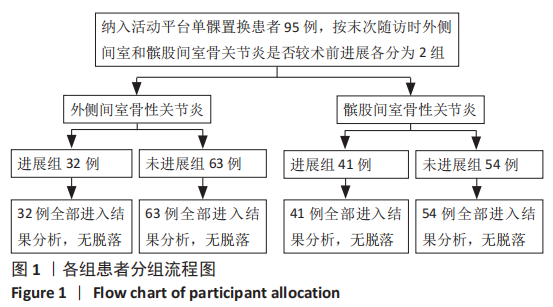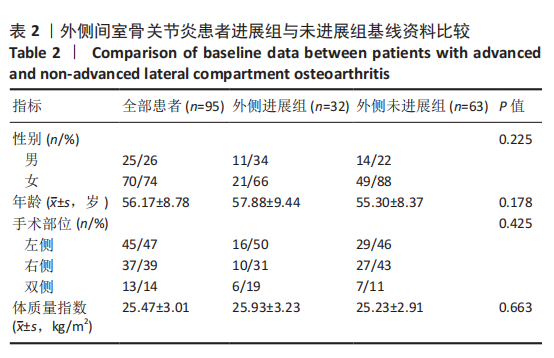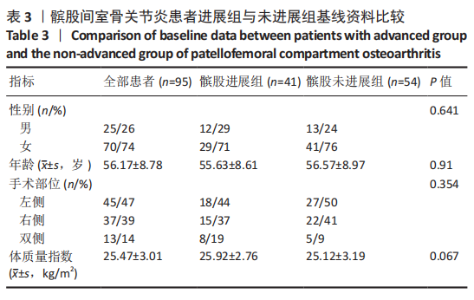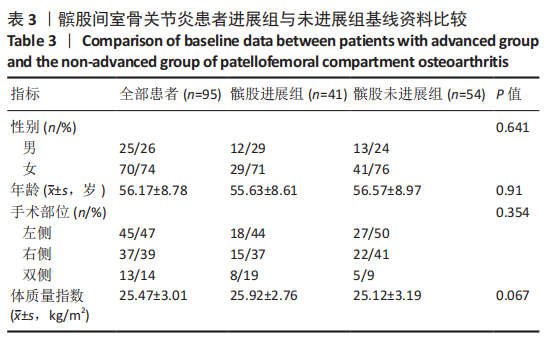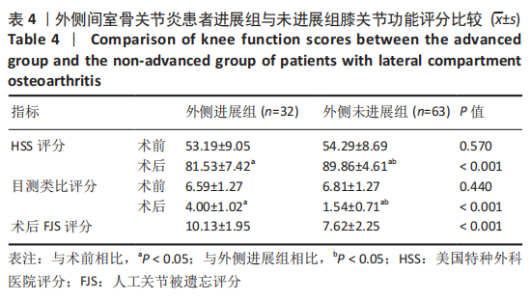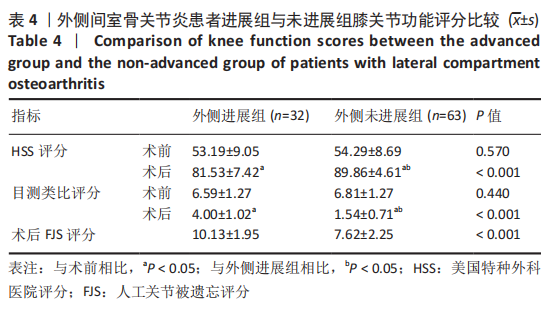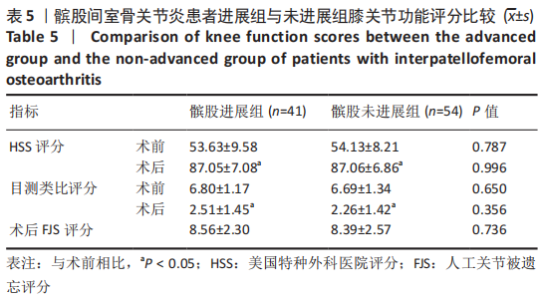Chinese Journal of Tissue Engineering Research ›› 2021, Vol. 25 ›› Issue (33): 5318-5323.doi: 10.12307/2021.320
Previous Articles Next Articles
Medium- and long-term assessment of lateral compartment and patellofemoral compartment osteoarthritis after medial unicompartmental knee arthroplasty with Oxford mobile-bearing
Qiao Renqiu, Yin Li, Zhang Yi, Wang Haitao, Xia Peige, Kong Zhiheng
- Department of Orthopedics, First Affiliated Hospital of Zhengzhou University, Zhengzhou 450000, Henan Province, China
-
Received:2021-01-25Revised:2021-01-27Accepted:2021-03-10Online:2021-11-28Published:2021-08-05 -
Contact:Yin Li, MD, Chief physician, Master’s supervisor, Department of Orthopedics, First Affiliated Hospital of Zhengzhou University, Zhengzhou 450000, Henan Province, China -
About author:Qiao Renqiu, Master candidate, Department of Orthopedics, First Affiliated Hospital of Zhengzhou University, Zhengzhou 450000, Henan Province, China
CLC Number:
Cite this article
Qiao Renqiu, Yin Li, Zhang Yi, Wang Haitao, Xia Peige, Kong Zhiheng. Medium- and long-term assessment of lateral compartment and patellofemoral compartment osteoarthritis after medial unicompartmental knee arthroplasty with Oxford mobile-bearing[J]. Chinese Journal of Tissue Engineering Research, 2021, 25(33): 5318-5323.
share this article
Add to citation manager EndNote|Reference Manager|ProCite|BibTeX|RefWorks
| [1] SATKU K. Unicompartmental knee arthroplasty: is it a step in the right direction? Surgical options for osteoarthritis of the knee. Singapore Med J. 2003;44(11):554-556. [2] van MIDDELKOOP M, BENNELL KL, CALLAGHAN MJ, et al. International patellofemoral osteoarthritis consortium: Consensus statement on the diagnosis, burden, outcome measures, prognosis, risk factors and treatment. Semin Arthritis Rheum. 2018;47(5):666-675. [3] WILSON HA, MIDDLETON R, ABRAM S, et al. Patient relevant outcomes of unicompartmental versus total knee replacement: systematic review and meta-analysis. BMJ. 2019;364:1352. [4] LUM ZC, LOMBARDI AV, HURST JM, et al. Early outcomes of twin-peg mobile-bearing unicompartmental knee arthroplasty compared with primary total knee arthroplasty. Bone Joint J. 2016;98-B(10 Supple B): 28-33. [5] LIDDLE AD, PANDIT H, JUDGE A, et al. Optimal usage of unicompartmental knee arthroplasty: a study of 41,986 cases from the National Joint Registry for England and Wales. Bone Joint J. 2015; 97-B(11):1506-1511. [6] MILLER S, AGARWAL A, HADDON WB, et al. Comparison of gait kinetics in total and unicondylar knee replacement surgery. Ann R Coll Surg Engl. 2018;100(4):267-274. [7] MURRAY DW, GOODFELLOW JW, O’CONNOR JJ. The Oxford medial unicompartmental arthroplasty: a ten-year survival study. J Bone Joint Surg Br. 1998;80(6):983-989. [8] HAMILTON TW, PANDIT HG, MAURER DG, et al. Anterior knee pain and evidence of osteoarthritis of the patellofemoral joint should not be considered contraindications to mobile-bearing unicompartmental knee arthroplasty: a 15-year follow-up. Bone Joint J. 2017;99-B(5):632-639. [9] FORNELL S, PRADA E, BARRENA P, et al. Mid-term outcomes of mobile-bearing lateral unicompartmental knee arthroplasty. Knee. 2018;25(6): 1206-1213. [10] KLEEBLAD LJ, BORUS TA, COON TM, et al. Midterm survivorship and patient satisfaction of robotic-arm-assisted medial unicompartmental knee arthroplasty: a multicenter study. J Arthroplasty. 2018;33(6): 1719-1726. [11] SIERRA RJ, KASSEL CA, WETTERS NG, et al. Revision of unicompartmental arthroplasty to total knee arthroplasty: not always a slam dunk. J Arthroplasty. 2013;28(8 Suppl):128-132. [12] CHENG T, CHEN D, ZHU C, et al. Fixed-versus mobile-bearing unicondylar knee arthroplasty: are failure modes different? Knee Surg Sports Traumatol Arthrosc. 2013;21(11):2433-2441. [13] KUMAR H, PAL CP, SHARMA YK, et al. Epidemiology of knee osteoarthritis using Kellgren and Lawrence scale in Indian population. J Clin Orthop Trauma. 2020;11(Suppl 1):S125-S129. [14] RANAWAT CS, INSALL J, SHINE J. Duo-condylar knee arthroplasty: hospital for special surgery design. Clin Orthop Relat Res. 1976;(120): 76-82. [15] HUSKISSON EC. Measurement of pain. Lancet. 1974;2(7889):1127-1131. [16] CAO S, LIU N, HAN W, et al. Simplified Chinese version of the Forgotten Joint Score (FJS) for patients who underwent joint arthroplasty: cross-cultural adaptation and validation. J Orthop Surg Res. 2017;12(1):6. [17] 王波,余楠生.膝骨关节炎阶梯治疗专家共识(2018年版)[J].中华关节外科杂志(电子版),2019,13(1):124-130. [18] PETERFY CG, GUERMAZI A, ZAIM S, et al. Whole-Organ Magnetic Resonance Imaging Score (WORMS) of the knee in osteoarthritis. Osteoarthritis Cartilage. 2004;12(3):177-190. [19] WANG K, XING D, DONG S, et al. The global state of research in nonsurgical treatment of knee osteoarthritis: a bibliometric and visualized study. BMC Musculoskelet Disord, 2019;20(1):407. [20] FORNELL S, PRADA E, BARRENA P, et al. Mid-term outcomes of mobile-bearing lateral unicompartmental knee arthroplasty. Knee. 2018;25(6):1206-1213. [21] 吴东,杨敏之,曹正,等.膝关节单髁置换术研究进展[J].中国修复重建外科杂志,2020,34(2):145-150. [22] SCHROER WC, BARNES CL, DIESFELD P, et al. The Oxford unicompartmental knee fails at a high rate in a high-volume knee practice. Clin Orthop Relat Res. 2013;471(11):3533-3539. [23] 刘晓东,凃意辉.膝关节单髁置换术的临床应用进展[J].中华关节外科杂志(电子版),2010,4(6):804-808. [24] 孙康,田少奇,张积华,等.膝关节单室置换的近期疗效[J].中华骨科杂志,2009,29(7):648-652. [25] KULSHRESTHA V, DATTA B, KUMAR S, et al. Outcome of unicondylar knee arthroplasty vs total knee arthroplasty for early medial compartment arthritis: a randomized study. J Arthroplasty. 2017;32(5): 1460-1469. [26] SUN PF, JIA YH. Mobile bearing UKA compared to fixed bearing TKA: a randomized prospective study. Knee. 2012;19(2):103-106. [27] BERGER RA, MENEGHINI RM, JACOBS JJ, et al. Results of unicompartmental knee arthroplasty at a minimum of ten years of follow-up. J Bone Joint Surg Am. 2005;87(5):999-1006. [28] SUN JN, CHEN W, ZHANG Y, et al. Does cognitive behavioral education reduce pain and improve joint function in patients after total knee arthroplasty? A randomized controlled trial. Int Orthop. 2020;44(10):2027-2035. [29] LYONS MC, MACDONALD SJ, SOMERVILLE LE, et al. Unicompartmental versus total knee arthroplasty database analysis: is there a winner? Clin Orthop Relat Res. 2012;470(1):84-90. [30] LIM JW, COUSINS GR, CLIFT BA, et al. Oxford unicompartmental knee arthroplasty versus age and gender matched total knee arthroplasty-functional outcome and survivorship analysis. J Arthroplasty. 2014; 29(9):1779-1783. [31] VAN DER LIST JP, ZUIDERBAAN HA, PEARLE AD. Why Do Medial Unicompartmental Knee Arthroplasties Fail Today? J Arthroplasty. 2016;31(5):1016-1021. [32] LIM JW, COUSINS GR, CLIFT BA, et al. Oxford unicompartmental knee arthroplasty versus age and gender matched total knee arthroplasty-functional outcome and survivorship analysis. J Arthroplasty. 2014;29(9):1779-1783. [33] KIM SJ, POSTIGO R, KOO S, et al. Causes of revision following Oxford phase 3 unicompartmental knee arthroplasty. Knee Surg Sports Traumatol Arthrosc. 2014;22(8):1895-1901. [34] PANDIT H, HAMILTON T W, JENKINS C, et al. The clinical outcome of minimally invasive Phase 3 Oxford unicompartmental knee arthroplasty: a 15-year follow-up of 1000 UKAs. Bone Joint J. 2015; 97-B(11):1493-1500. [35] LORBACH O, PAPE D, MOSSER P, et al. Medial unicondylar knee replacement. Orthopade. 2014;43(10):875-876,878-882. [36] MOFIDI A, LU B, PLATE JF, et al. Effect of arthritis in other compartment after unicompartmental arthroplasty. Eur J Orthop Surg Traumatol. 2014;24(5):805-812. [37] BEREND KR, LOMBARDI AJ, MORRIS MJ, et al. Does preoperative patellofemoral joint state affect medial unicompartmental arthroplasty survival? Orthopedics. 2011;34(9):e494-e496. [38] SONG EK, PARK JK, PARK CH, et al. No difference in anterior knee pain after medial unicompartmental knee arthroplasty in patients with or without patellofemoral osteoarthritis. Knee Surg Sports Traumatol Arthrosc. 2016;24(1):208-213. [39] KALAAI S, SCHOLTES M, BORGHANS R, et al. Comparable level of joint awareness between the bi-cruciate and cruciate retaining total knee arthroplasty with patient-specific instruments: a case-controlled study. Knee Surg Sports Traumatol Arthrosc. 2020;28(6):1835-1841. [40] THIENPONT E, ZORMAN D. Higher forgotten joint score for fixed-bearing than for mobile-bearing total knee arthroplasty. Knee Surg Sports Traumatol Arthrosc. 2016;24(8):2641-2645. [41] BEHREND H, GIESINGER K, GIESINGER JM, et al. The “forgotten joint” as the ultimate goal in joint arthroplasty: validation of a new patient-reported outcome measure. J Arthroplasty. 2012;27(3):430-436. [42] PEERSMAN G, VERHAEGEN J, FAVIER B. The forgotten joint score in total and unicompartmental knee arthroplasty: a prospective cohort study. Int Orthop. 2019;43(12):2739-2745. [43] ZUIDERBAAN HA, van der LIST JP, KHAMAISY S, et al. Unicompartmental knee arthroplasty versus total knee arthroplasty: which type of artificial joint do patients forget? Knee Surg Sports Traumatol Arthrosc. 2017;25(3):681-686. (责任编辑:WJ,ZN,ZH) |
| [1] | Peng Zhihao, Feng Zongquan, Zou Yonggen, Niu Guoqing, Wu Feng. Relationship of lower limb force line and the progression of lateral compartment arthritis after unicompartmental knee arthroplasty with mobile bearing [J]. Chinese Journal of Tissue Engineering Research, 2021, 25(9): 1368-1374. |
| [2] | Huang Dengcheng, Wang Zhike, Cao Xuewei. Comparison of the short-term efficacy of extracorporeal shock wave therapy for middle-aged and elderly knee osteoarthritis: a meta-analysis [J]. Chinese Journal of Tissue Engineering Research, 2021, 25(9): 1471-1476. |
| [3] | Liu Xiangxiang, Huang Yunmei, Chen Wenlie, Lin Ruhui, Lu Xiaodong, Li Zuanfang, Xu Yaye, Huang Meiya, Li Xihai. Ultrastructural changes of the white zone cells of the meniscus in a rat model of early osteoarthritis [J]. Chinese Journal of Tissue Engineering Research, 2021, 25(8): 1237-1242. |
| [4] | Zhao Zhongyi, Li Yongzhen, Chen Feng, Ji Aiyu. Comparison of total knee arthroplasty and unicompartmental knee arthroplasty in treatment of traumatic osteoarthritis [J]. Chinese Journal of Tissue Engineering Research, 2021, 25(6): 854-859. |
| [5] | Liu Shaohua, Zhou Guanming, Chen Xicong, Xiao Keming, Cai Jian, Liu Xiaofang. Influence of anterior cruciate ligament defect on the mid-term outcome of fixed-bearing unicompartmental knee arthroplasty [J]. Chinese Journal of Tissue Engineering Research, 2021, 25(6): 860-865. |
| [6] | Liu Xin, Yan Feihua, Hong Kunhao. Delaying cartilage degeneration by regulating the expression of aquaporins in rats with knee osteoarthritis [J]. Chinese Journal of Tissue Engineering Research, 2021, 25(5): 668-673. |
| [7] | Ma Zetao, Zeng Hui, Wang Deli, Weng Jian, Feng Song. MicroRNA-138-5p regulates chondrocyte proliferation and autophagy [J]. Chinese Journal of Tissue Engineering Research, 2021, 25(5): 674-678. |
| [8] | Cao Xuhan, Bai Zixing, Sun Chengyi, Yang Yanjun, Sun Weidong. Mechanism of “Ruxiang-Moyao” herbal pair in the treatment of knee osteoarthritis based on network pharmacology [J]. Chinese Journal of Tissue Engineering Research, 2021, 25(5): 746-753. |
| [9] | Li Yonghua, Feng Qiang, Tan Renting, Huang Shifu, Qiu Jinlong, Yin Heng. Molecular mechanism of Eucommia ulmoides active ingredients treating synovitis of knee osteoarthritis: an analysis based on network pharmacology [J]. Chinese Journal of Tissue Engineering Research, 2021, 25(5): 765-771. |
| [10] | Song Shan, Hu Fangyuan, Qiao Jun, Wang Jia, Zhang Shengxiao, Li Xiaofeng. An insight into biomarkers of osteoarthritis synovium based on bioinformatics [J]. Chinese Journal of Tissue Engineering Research, 2021, 25(5): 785-790. |
| [11] | Deng Zhenhan, Huang Yong, Xiao Lulu, Chen Yulin, Zhu Weimin, Lu Wei, Wang Daping. Role and application of bone morphogenetic proteins in articular cartilage regeneration [J]. Chinese Journal of Tissue Engineering Research, 2021, 25(5): 798-806. |
| [12] | Fang Xin, Guo Jinming, Liu Pinduan. Different concentrations of platelet rich plasma in the repair of cartilage defects in rabbits with knee osteoarthritis [J]. Chinese Journal of Tissue Engineering Research, 2021, 25(35): 5588-5593. |
| [13] | Fan Shuai, Lin Jiebin, Wu Chunfei, Xu Zhaohui. Effect of serum containing Bushen Tiaogan prescription on interleukin-1beta-induced chondrocyte apoptosis [J]. Chinese Journal of Tissue Engineering Research, 2021, 25(35): 5594-5598. |
| [14] | Sun Mingshuai, Fan Chongshan, Li Kaijie, Gao Ruiyong, Wang Yudong, Shen Ruixue, Wang Lihe. Role of chondrocyte autophagy in osteoarthritis and its targeted therapy [J]. Chinese Journal of Tissue Engineering Research, 2021, 25(35): 5688-5693. |
| [15] | Wang Weikang, Liu Xiaodong, Zhou Changlin, Tian Jun. Regulatory role of microRNAs in the occurrence and development of osteoarthritis [J]. Chinese Journal of Tissue Engineering Research, 2021, 25(35): 5709-5715. |
| Viewed | ||||||
|
Full text |
|
|||||
|
Abstract |
|
|||||

